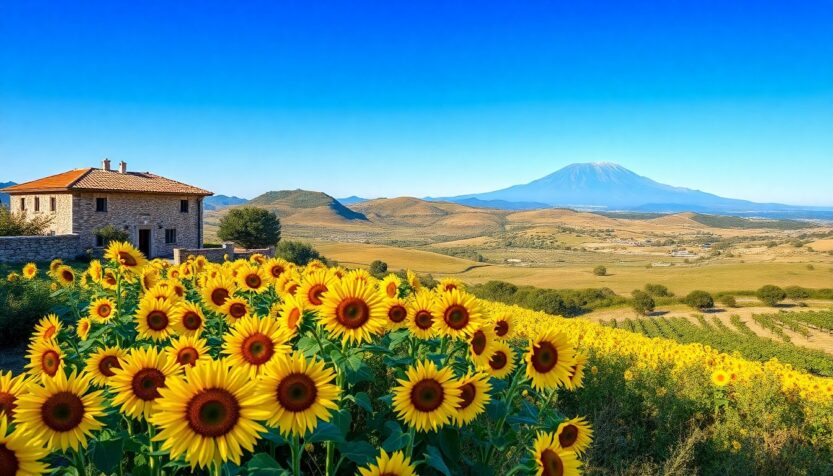When one thinks of Italy, the picturesque landscapes of Tuscany or the bustling streets of Rome may come to mind. However, Sicily stands apart as an autonomous region with its own rich identity and cultural heritage. Encompassing less than 10,000 square miles, this Mediterranean jewel encapsulates a diverse array of historical significance, stunning vistas, and a culinary tradition that reflects its multifaceted history.
Often hailed as the ultimate vacation locale, Sicily offers not only sun-soaked beaches and delectable cuisine but also a plethora of unique experiences that may surprise even seasoned travelers. From the rugged mountains to the serene coastlines, the island is a tapestry of natural wonders and historical sites.
A land of diverse landscapes and adventure
Geographically, Sicily is the largest island in the Mediterranean, shaped like a triangle and nestled just 1.5 miles from the Italian mainland. The island is dotted with various natural wonders, including towering volcanoes, lush nature reserves, and remnants of ancient civilizations. The coastline, stretching over 900 miles, is a magnet for those seeking relaxation on its soft sandy beaches or adventure in its crystalline waters.
The majestic Mount Etna
One of the island’s most iconic landmarks is Mount Etna, the largest active volcano in Europe. With its frequent lava flows and ash clouds, Etna captivates tourists and profoundly influences the surrounding communities. Its most catastrophic eruption in 1669 led to the reconstruction of towns like Catania, alongside the famous Baroque towns of the Val di Noto, which are now UNESCO World Heritage Sites. Adventurous visitors can explore its rugged terrain through organized jeep tours or hike up to its peak for stunning views.
Exploring the Aeolian Islands
The striking Aeolian Islands are another testament to Sicily’s geological diversity. Known for their volcanic activity, islands like Vulcano and Stromboli offer a different kind of thrill, with the latter showcasing nightly eruptions that resemble natural fireworks. These islands are breathtaking and provide insights into the natural forces that have shaped the region.
A culinary journey through time
Sicilian cuisine is a reflection of its storied past, influenced by various cultures over centuries. While many associate Italian wine with regions like Tuscany, Sicily boasts a vibrant wine-making tradition that dates back to ancient Greek times. The island’s favorable climate, combined with its rich volcanic soil, has made it one of Italy’s top wine-producing regions, known for exceptional varieties like Nero d’Avola and Etna Bianco.
When it comes to dessert, Sicilians have a unique tradition of enjoying gelato even for breakfast. Picture a warm brioche bun filled with creamy gelato, paired with a robust espresso – a delightful way to start the day. The classic flavors of pistachio, almond, and citrus reflect the island’s rich agricultural heritage, influenced by Arab traders who introduced sugarcane and citrus fruits in the 9th century.
The art of honey production
If you find yourself in the Iblei Mountains, the region is renowned for its exceptional honey, particularly the aromatic wild thyme honey. This sweet treat has historical significance, cherished by the ancient Greeks for its unique fragrance and health benefits. Today, visitors can indulge in honey tastings and learn about traditional beekeeping practices, particularly in towns like Zafferana Etnea, where honey production thrives thanks to the region’s rich biodiversity.
Cultural treasures and stunning vistas
Historically known as Magna Graecia, Sicily was a hub of Greek civilization, and remnants of this legacy can still be seen in well-preserved ancient temples and ruins scattered across the island. Cities like Agrigento and Syracuse were once as influential as their counterparts in Greece, showcasing impressive architecture and rich histories that continue to attract scholars and tourists alike.
The grandeur of Teatro Massimo
For those inclined towards the performing arts, the Teatro Massimo Vittorio Emanuele in Palermo stands as Italy’s largest opera house. Completed between 1875 and 1897, this magnificent neoclassical structure draws visitors not just for its performances but also for its architectural beauty, featuring grand columns and a monumental staircase that famously appeared in The Godfather Part III.
Often hailed as the ultimate vacation locale, Sicily offers not only sun-soaked beaches and delectable cuisine but also a plethora of unique experiences that may surprise even seasoned travelers. From the rugged mountains to the serene coastlines, the island is a tapestry of natural wonders and historical sites.0
Often hailed as the ultimate vacation locale, Sicily offers not only sun-soaked beaches and delectable cuisine but also a plethora of unique experiences that may surprise even seasoned travelers. From the rugged mountains to the serene coastlines, the island is a tapestry of natural wonders and historical sites.1

